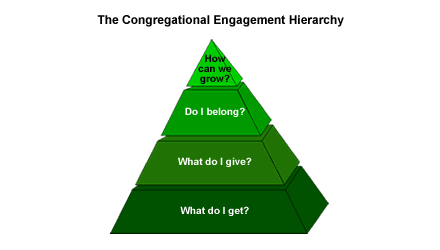This is the first in a series on the congregational engagement hierarchy.
In our recent series on the 12 items of congregational engagement, we examined how each of the items relates to the relevant outcomes of inviting, serving, giving, and life satisfaction (see "The ‘Bottom Line' on Congregational Engagement" in Related Items). However, the engagement variable affects more than these four outcomes. When strategically grouped, the items that measure engagement address some basic, intrinsic human needs. Humans are social beings -- we seek and form social groups in order to find common purpose and meaning, and to grow and expand our emotional and intellectual horizons. Religious congregations are well positioned to meet these social needs.
Statistical analysis of the items that measure engagement with any organization indicates they can be organized in a way that addresses four basic questions:
- What do I get? This is an elementary need -- the need to receive something of value -- that forms the foundation of any organization to which an individual commits. Engaged members believe they receive something valuable from belonging to their faith communities.
- What can I give? Human beings have an innate need to give of themselves. Congregations are ideally suited to meet this need, and engaged members feel that they make a valuable contribution to the success and effectiveness of their faith communities.
- Do I belong? People naturally want to fit in with the others in the groups to which they belong. Another way to ask this question is, "Am I valued?" Engaged members feel that they belong in their congregations and they also feel valued by them.
- How can we grow? The human desire to learn and grow --intellectually, spiritually and emotionally -- is a need that individuals expect to meet in their congregations. Standing still is not an option; engaged members believe that they have grown by being part of their faith communities.
The resolution of each of these "belonging" questions is necessary in order to move on to the following one – thus, the set can be viewed as a pyramid, with each level building upon the other and creating a "hierarchy of engagement."

Key Points
When new members join a faith community, they first ask, "What do I get?" in an attempt to decide if belonging to this organization is worth their investment of time, effort and self. If they determine that they will receive enough value from joining, they will then ask, "What can I give?" and look for ways that their unique talents can contribute to the congregation. From there they will ask, "Do I belong?" as they look for signs that they are valued. When they know that they receive something of value from belonging, that they make a meaningful contribution to the life of the congregation, and that they are valued, they will then look for signs that the organization's members are growing in their faith. Recognizing this process is vitally important for congregation leaders intent upon improving engagement levels among their members.
In the weeks ahead, we will examine in further detail each level of the congregational engagement pyramid, and the engagement items that make up each level.
